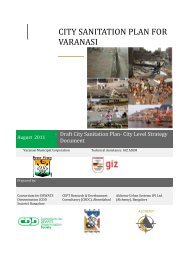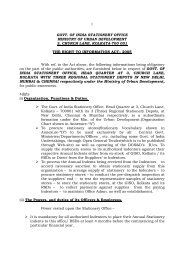CITY SANITATION PLAN - Ministry of Urban Development
CITY SANITATION PLAN - Ministry of Urban Development
CITY SANITATION PLAN - Ministry of Urban Development
Create successful ePaper yourself
Turn your PDF publications into a flip-book with our unique Google optimized e-Paper software.
<strong>CITY</strong> <strong>SANITATION</strong> <strong>PLAN</strong> BAREILLY<br />
fall in comply with the national vision <strong>of</strong> NUSP. Needless to mention, the plans attract huge money in<br />
terms <strong>of</strong> grants and in terms <strong>of</strong> donation from international donors apart from the existing financial<br />
structure for promoting sanitation at the ULB level.<br />
6.3.7 IEC AND AWARENESS ACTION <strong>PLAN</strong><br />
In the process related parameters <strong>of</strong> city sanitation rating methodology, Monitoring & Evaluation<br />
system for tracking open defecation find their place. Of the total 4 points given to this category,<br />
Bareilly has scored no point. Here is where initiating IEC and awareness programmes can help the<br />
municipality gain some important points. A sustained grassroots campaign couple with adequate<br />
mass media exposure is a mix that will deliver the required results. Community participation backed<br />
by improved municipal services can help Bareilly open defecation free status. Neighborhood groups<br />
such as women’s self help groups and school children can be sensitized to the issue <strong>of</strong> open<br />
defecation. Having a community monitoring system has been found to be very effective in several<br />
cities. A community level group can be formed to dissuade open defecation. For instance, a group <strong>of</strong><br />
school children armed with vigils can alert the community to anyone trying to defecate in open.<br />
Nagar Nigam sanitary inspectors and safai karamcharies can patrol marked open defecation areas.<br />
Making random visits to open defecation areas early in the morning can be institutionalized to arrest<br />
open defecation.<br />
Process Related<br />
NO INDICATORS TOTAL<br />
POINTS<br />
POINTS<br />
SECURED<br />
A M&E systems are in place to track incidences <strong>of</strong> open defecation 4 0<br />
Reduction in water borne diseases in another area <strong>of</strong> focus for the nagar nigam as it has score 02<br />
points in this category. Further IEC can help in generating awareness required to bring down the<br />
incidence <strong>of</strong> water borne diseases. The City Sanitation Ranking methodology has given weight to<br />
reducing water-borne diseases. The IEC campaign can take up personal and community hygiene as<br />
key themes. These would include water-borne diseases, other communicable ailments including skin<br />
diseases to make it more comprehensive.<br />
ADMINISTRATIVE STAFF COLLEGE OF INDIA, HYDERABAD Page 196
















